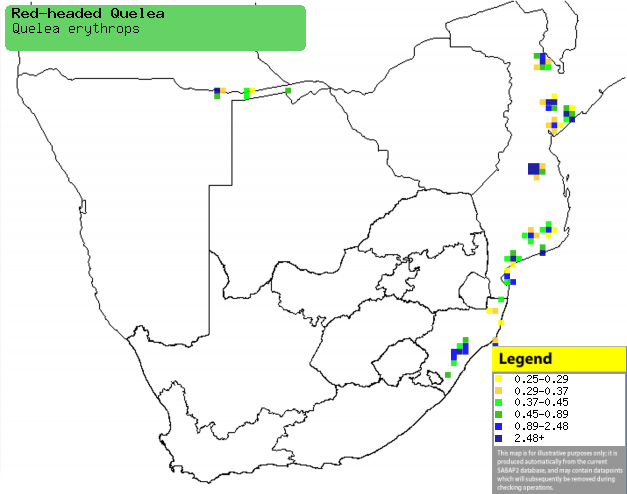|
Quelea erythrops (Red-headed
quelea)
Rooikopkwelea [Afrikaans]; Roodkopwever [Dutch]; Travailleur à
tête rouge [French]; Rotkopfweber [German]; Quelea-de-cabeça-vermelha
[Portuguese]
Life
> Eukaryotes >
Opisthokonta
> Metazoa (animals) >
Bilateria >
Deuterostomia > Chordata >
Craniata > Vertebrata (vertebrates) > Gnathostomata (jawed
vertebrates) > Teleostomi (teleost fish) > Osteichthyes (bony fish) > Class:
Sarcopterygii (lobe-finned
fish) > Stegocephalia (terrestrial
vertebrates) > Tetrapoda
(four-legged vertebrates) > Reptiliomorpha > Amniota >
Reptilia (reptiles) >
Romeriida > Diapsida > Archosauromorpha > Archosauria >
Dinosauria
(dinosaurs) > Saurischia > Theropoda (bipedal predatory dinosaurs) >
Coelurosauria > Maniraptora > Aves
(birds) >
Order: Passeriformes > Family: Ploceidae
> Genus: Quelea
Distribution and habitat
Occurs from West Africa to across much of the DRC and
surrounding countries, with isolated populations from southern Tanzania through
north-eastern Mozambique to southern Africa. Here it is uncommon in the Caprivi
Strip of Namibia and localised patches of Mozambique, extending south to KwaZulu-Natal,
South Africa. It generally prefers grassland near water in southern Africa, but
in other areas of its distribution it also occupies cultivated areas, such as
rice paddies.
|
 |
|
Distribution of Red-headed quelea in southern Africa,
based on statistical smoothing of the records from first SA Bird Atlas
Project (©
Animal Demography unit, University of
Cape Town; smoothing by Birgit Erni and Francesca Little). Colours range
from dark blue (most common) through to yellow (least common).
See here for the latest distribution
from the SABAP2. |
Movements and migrations
It is primarily a breeding migrant to southern
Africa, mainly present from about July-November (recorded in East
London, KwaZulu-Natal.)
Food
The following food items have been recorded in its diet:
- Grass seeds
- Echinochloa
- Rottboellia
- Pennisetum
- Insects
Breeding
- Polygynous, highly colonial breeder, living in colonies with hundreds to
thousands of nests, sometimes up to about 10 000!
- The nest is built by the male in about 3 days, consisting of an
oval-shaped structure with a side entrance covered by a hood made of tightly
woven green grass blades, typically suspended between reed stems.
- Egg-laying season is from November-March.
- It lays 1-3 eggs, which are incubated solely by the female for about
12-14 days, but she may leave the nest for long periods.
- The chicks are fed solely by the female, leaving the nest after about
12-14 days.
Threats
Not threatened.
References
-
Hockey PAR, Dean WRJ and Ryan PG 2005. Roberts - Birds of
southern Africa, VIIth ed. The Trustees of the John Voelcker Bird Book
Fund, Cape Town.
|
